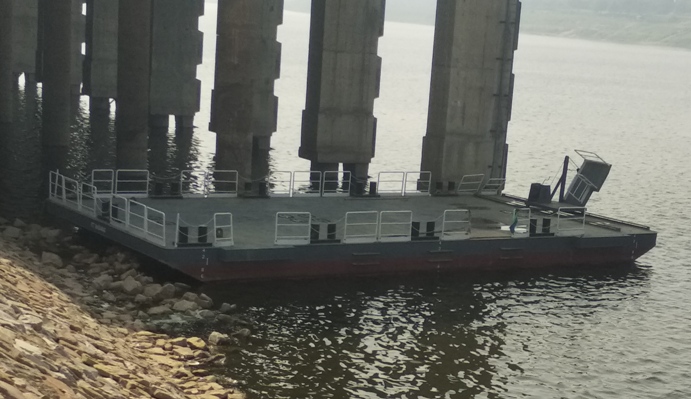Since you’ve landed here looking for pontoon DIY guides, I assume you’re a Pontoon enthusiast.
Pontoons are very long in dimension and also they contain much reserve buoyancy, and allow designers to create massive deck plans fitted with all sorts of accommodations such as expansive lounge areas, stand-up bars, and sun pads.
Apart from above uses the major benefit of the pontoon in the river for loading and unloading of man, machine, and material. Large pontoons are made of aluminum and steel plates.
The do-it-yourself types are people who have a focused path of their future floating pontoon and skills to make it happen. The good of doing things themselves is important to them, and at least to some extent, also the desire to save money.
Pointer for building a Pontoon:
Just in case you don’t know much about a pontoon, it is a flat structure that relies on floats to remain buoyant! Building a pontoon, even if you’re a DIY enthusiast, is not an easy task, it will take lots of time, energy, planning, and money.
There are a few basic points we can consider while building a pontoon:
- Design
- Fabrication
- Supply
- Erection
- Suitable anchoring system
- Painting of pontoon
The pontoon shall be built as per the shipping rule.
When designing the pontoon is completed by the design department, the fabrication of the pontoon is started.
In the fabrication process, there are a lot of steel material, consumable items, and manpower is used.
Apart from the fabrication of pontoon, various steel outfitting material is also fabricated in pontoon like Handrail, Gangway, and bollard steel, etc.
Normal shipbuilding practices are considered while we build a pontoon.
Principal particulars required like Length, Breath, freeboard, and type of pontoon.
Environmental condition:
Before building a pontoon do it yourself, we need to consider a few environment parameters like:
1) Average wind speed
2) Maximum current speed
3) Maximum river water temperature
The steel to be used is to be of grade 2062. Welding is to be of high quality and using high-quality electrodes.
For building a pontoon various size of the plate is used, which are given below:
- Bottom plating(8mm)
- Side plating(6mm)
- End bulkheads(6mm)
- Internal bulkhead(6mm)
- Deck plating ( Mostly it is chakkar plate)(6mm)
- Tank boundaries(6 mm)
The pontoons shall be built with shipbuilding quality steel of 2062 grade or equivalent with all-welded construction. Necessary hull prevention and painting to be carried out as per shipbuilding practice and paint scheme.
Approved shipbuilding quality material is to be used throughout the construction. In the process of building a pontoon good continuity of structural members in basic hull structure should be maintained.
Flanging of plates and brackets, shall not be allowed. In shipbuilding, for bolts, only drilling is allowed.
Before the steel plates and rolled sections are used for construction, rust and mill scale must be removed by means of sand/grit blasting.
Immediately after the steel sand/grit blasting, one coat of zinc-rich shop primer with a thickness of a minimum of 25 microns is to be applied as protection.
Floating pontoon cost :

Floating pontoon cost includes various factors like:
- Pontoon fabrication
- Steel plate
- Consumable materials (Welding rod, Welding machine, etc.)
- Skilled manpower
Pontoon Anchor Winch:
A pontoon anchor winch is a machine used on pontoons and ships that are used to let out and heave up equipment such as a pontoon anchor. On some pontoon, it may be located in a specific room called the windlass room.
The winch is usually followed by an electric or hydraulic motor operating through a gear train.
Floating pontoon platforms:

Floating pontoon platforms are usually airtight hollow or flat structure, which is built for aircraft and marine engineering applications.
Types of fenders for ships:
In shipbuilding there are various types of fenders for ships are used. A fender is a bumper that basically absorbs the kinetic energy of pontoon, ships, and vessel berthing against the jetty wall or other vessel.
Fenders, used on all types of vessels, from cargo ships to cruise ships, ferries, and personal yachts, prevent damage to vessels and berthing structures.
To do this, fenders have high energy absorption and low reaction force. Fenders are manufactured by rubber, foam, elastomer, and plastic.
Gangway ship

Gangway ship is a path between dock and pontoon . Without a gangway ship, we are not able to move from ship to dock. Depending upon the weight of ship and pontoon builder built a gangway.
Ship gangway design:
Before building a ship gangway, we need an approved ship gangway design by an engineer. Without gangway design, we are not able to go forward in the ship and pontoon building process.
Bollards steel :

Bollards steel is a short and vertical post. It is referred to as a post in a ship and pontoon typically for mooring pontoon. Presently it is also referred to as a post to controlled road traffic.
Checker Plate Thickness Chart:

Checker plates is also known as chequer plates are metal plates with different types of shapes that are present on one side, while the other side remains smooth. The material used for making these Checker plate is stainless steel, mild steel, and aluminum. Checker Plate Thickness Chart used to find the thickness, length, and width of the plate.
Triple Engine Pontoon Boat:
Triple Engine Pontoon Boat You must have seen those flatter boats with an expansive lounge area in one of your summer escapades to the shores. These are called pontoon boats.
Winch machine use:
A winch is a mechanical machine used to pull in (wind up) or let out (wind out) or otherwise adjust the tension of a rope or wire rope. Winch machines used in various industries like Shipbuilding, Marine, Aircraft recovery, and vehicle recovery, and for launching a pontoon /ships, etc.

